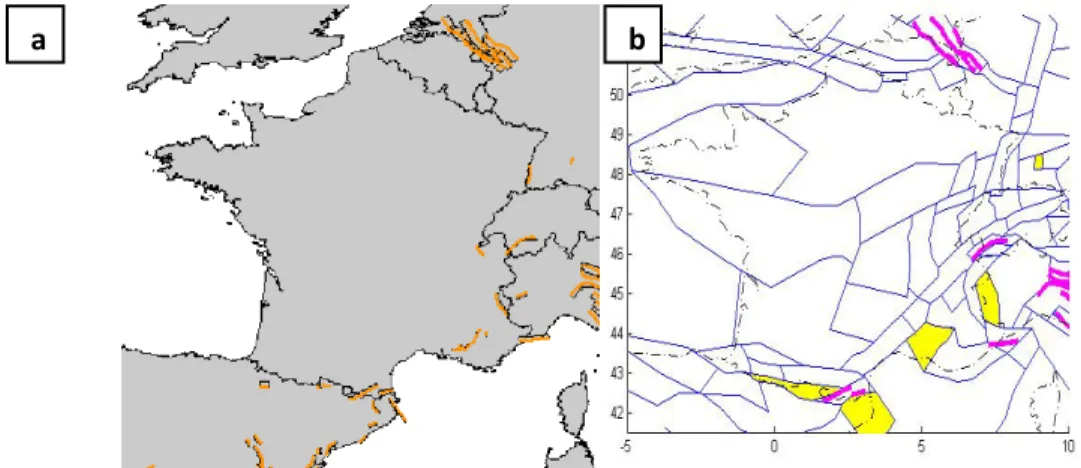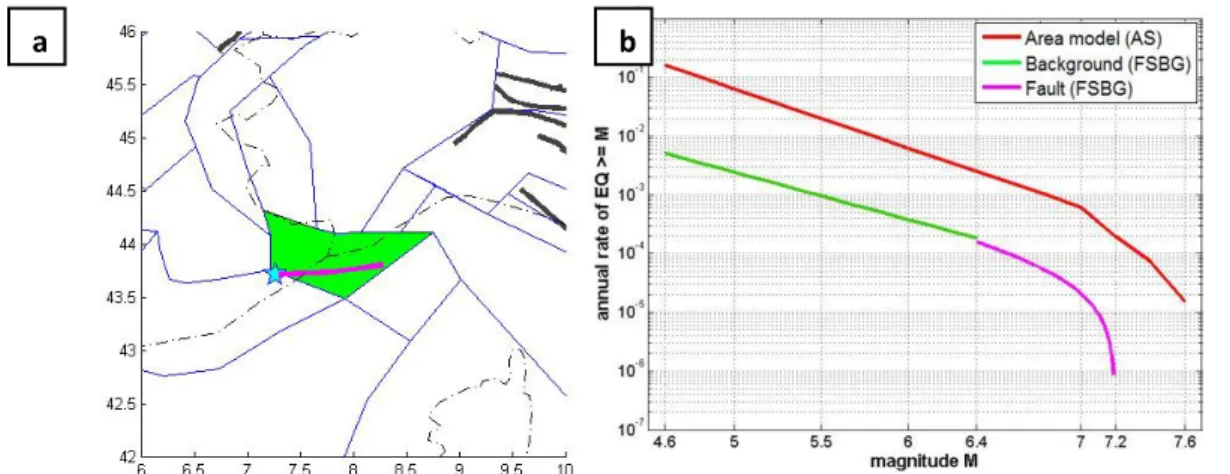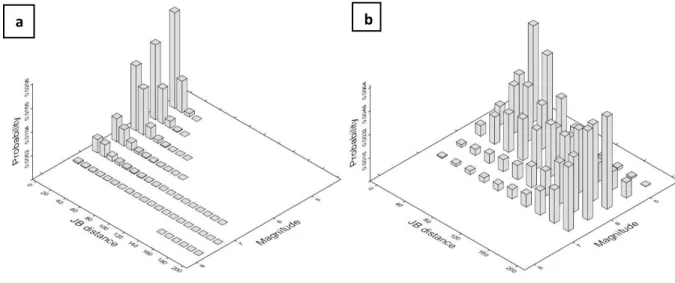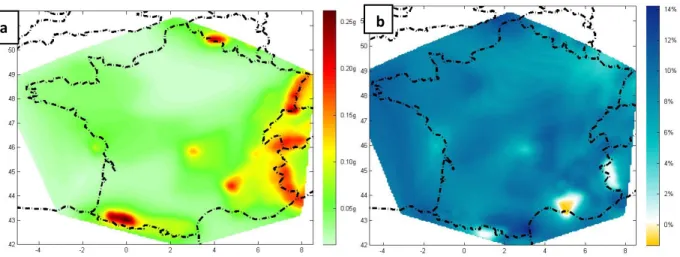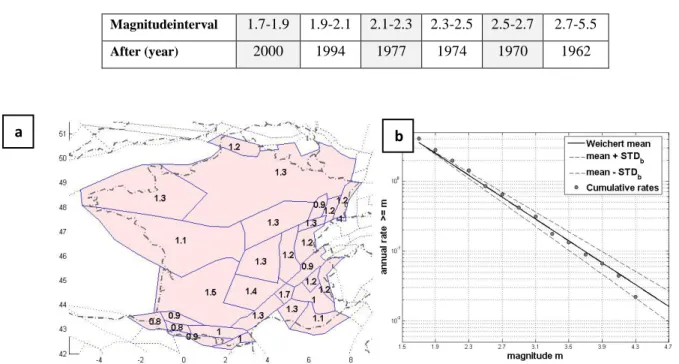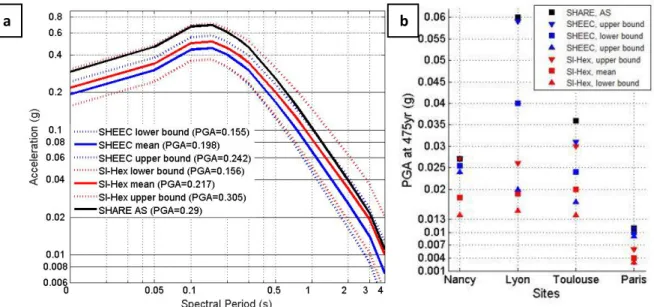HAL Id: insu-01742609
https://hal-insu.archives-ouvertes.fr/insu-01742609
Submitted on 25 Mar 2018
HAL is a multi-disciplinary open access
archive for the deposit and dissemination of
sci-entific research documents, whether they are
pub-lished or not. The documents may come from
teaching and research institutions in France or
abroad, or from public or private research centers.
L’archive ouverte pluridisciplinaire HAL, est
destinée au dépôt et à la diffusion de documents
scientifiques de niveau recherche, publiés ou non,
émanant des établissements d’enseignement et de
recherche français ou étrangers, des laboratoires
publics ou privés.
application to France
I Grigoratos, C. Beauval, Pierre-Yves Bard, Myriam Belvaux, Claudia
Aristizabal
To cite this version:
I Grigoratos, C. Beauval, Pierre-Yves Bard, Myriam Belvaux, Claudia Aristizabal. Sensitivity study
on the SHARE PSHA model and exploration of uncertainties on earthquake recurrence – application
to France . 9ème Colloque National AFPS2015, Nov 2015, Marne-la-Vallée, France. �insu-01742609�
9èmeColloque National AFPS 2015 – IFSTTAR
Sensitivity study on the SHARE PSHA model and
exploration of uncertainties on earthquake recurrence –
application to France
Étudede sensibilitésur le modèle PSHA de SHARE et
exploration des incertitudesliées aux modèles de sismicité –
application à la France
I.Grigoratos
1, C.Beauval
1, P-Y.Bard
1, M.Belvaux
2andC.Aristizabal
1 1ISTerre,
Univ. Grenoble Alpes-CNRS-IRD-IFSTTAR, Grenoble
2
Bureau de Recherches Géologiques et Minières (BRGM), Orléans
RÉSUMÉ. Le projet SHARE a produit fin 2013 des cartesharmonisées de l’aléasismique pour l’ensemble de la région euro-méditerranéenne. La présenteétudeestmenéedans le cadre d’un groupe de travail de l’AFPSayant pour objectifd’analyser les méthodesproposéesdans SHARE et les résultats pour la France. Les modèles de SHARE, pour la France, reposentfortementsur des critèresd’expert. La sensibilité des résultats au choixdes magnitudes minimalesetmaximalesestquantifiée. Le modèleintégrant les faillesestanalysé et son impact surl’aléaestquantifié. Des erreursdans les fichiersd’entréesontidentifiées, etune carte corrigéeestproduite. Afin de quantifier les incertitudessur le modèle de source, nous avonsrepris le catalogue de sismicité de SHARE (SHEEC), etavonsétabli des courbes de récurrence avec incertitude. Enparallèle, le SI-Hex catalogue de sismicitéunifiéethomogènerécemmentpublié par Cara et al. (2015) a étéexploité pour fournir des modèles de récurrencealternatifs. Les estimations d’aléasismiqueprobabilistebaséessurcesdifférentsmodèles de sources montrentquel’impactsurl’aléaest important. Plus d’attentiondevraitêtreapportée aux modèles de source et à la quantification des incertitudes qui les caractérisent.
SUMMARY. In 2013, the SHARE project delivered a harmonized model characterizing the seismic hazard in the entire Euro-Mediterranean region. This study is led within the framework of an adhoc AFPS working group discussing the SHARE assumptions, methodologies and results for France.TheSHARE earthquake recurrence models for France rely greatly on expert opinion. A sensitivity study on some input model parametersis performed (minimum and maximum magnitudes contributing to the hazard). The impact of the fault model on the hazard is studied. Some errors in the input files are identified, a corrected hazard map is produced. In an attempt to account for the uncertainties on the source model, new recurrence curves with associated uncertainties are derivedbased on SHARE’s earthquake catalog (SHEEC). The recently published SI-Hex catalog, anew unified instrumental catalog for France (Cara et al., 2015) is also used to derive alternative recurrence curves. Based on these new source models, alternativePSH estimates are obtained for France.The results show that the uncertainty on the recurrence parameters in France is large and that the impact on hazard can be so large that it should not be neglected.
MOTS-CLÉS : PROBABILISTE ; SHARE ; SENSIBILITE ; ALEA SISMIQUE ; FRANCE KEYWORDS:PSHA ; SHARE ; SI-HEX ; SENSITIVITY ; SEISMIC HAZARD ; FRANCE
1. Ιntroduction
The most commonly used approach to determine seismic-design loads for engineering projects nowadays is probabilistic seismic-hazard analysis (PSHA). The primary output from a PSHA is a hazard curve showing the variation of a selected ground-motion parameter against the annual rate of exceedance. The design value is the ground-motion level that corresponds to a preselected design return period. It is fundamental to understand the mechanics of this PSHA approach thoroughly, in order to clearly define its limitations and uncertainties, and thus the confidence levels of the results it provides. The present study analyses the SHARE calculations and results for France, and proposes new earthquake recurrence models with associated uncertainties, with the ultimate aim to evaluate the impact on hazard results.
2. SHARE project
The SHARE project created a time-independent hazard model for the Euro-Mediterranean region (Giardini et al., 2014). It is intended to serve as reference model of the updated European seismic regulations for building design.The SHARE Deliverables are describing the methodologies followed andsome of the decisions taken (www.efehr.org). PSHA is calculated with the software OpenQuake (Silva et al., 2014).
Epistemic uncertainties are addressed within a logic-tree approach. The two main PSHA components, earthquake source and ground shaking, are included in different branching levels. Three mean source models are included in the logic tree; the uncertainty on each model is not explored in the logic tree.SHARE includes a tectonic regionalization to apply the selected Ground Motion Prediction Equations (GMPE, Delavaud et al., 2012), classifying the seismic sources either as Active Shallow Crust (ASC, 4 GMPEs) or as Stable Continental Regions (SCR, 5 GMPEs). All calculations are performed for rock site conditions. The hazard results are available for return periods ranging from 73 to 4975 years and for spectral periods till 4.0 seconds(www.efehr.org).
Some of thedecisions and methods mentioned in the Deliverables were revised in the final hazard calculations. These decisions can thus only be understood by analysing the Shapefilesdescribing the source model, and the OpenQuake input files, available on thewww.efehr.orgwebsite.
3. Analysis and sensitivity study on SHARE source model for France 3.1 Source model logictree and area+fault model
SHARE includes in the logic treethree models to forecast earthquake activity. These mean models result from alternative interpretations of the available tectonic, paleoseismic, geological and seismological data:
• AS (weight 0.5) is an area source model, relying on a seismotectonic zoning and past seismicity. The earthquake recurrence is modeled by a Gutenberg-Richter curve.
• FSBG (weight 0.2) combines active faults (Basili et al., 2013) with background seismicity. Where no fault istaken into account, the source zones in the FSBG model are identical to the ASmodel ones.For source zone including active faults, the earthquake recurrence is modeled by a Gutenberg-Richter curve: the a-value is derived from the geologic slip rate of the fault (Basili et al., 2013), applying the Anderson and Luco (1983) method, using the b-value from the area model and the maximum magnitude attributed to the fault (defined in Basili et al.,2013). Magnitudes below or equal to Mw 6.4 are assigned to the background, magnitudes larger than 6.4 to the fault plane.
9èmeColloque National AFPS 2015 – IFSTTAR 3
Initially, SHARE had planned to includethe faults displayed inFig. 1a, but in the course of the project, only a subset of these faults has been kept, i.e. faults with highestslip ratesand Mmax> 6.5 (L. Danciu personal communication, Fig. 1b).
• SEIFA (weight 0.3) is based on kernel density estimation techniques in space, applied to both past earthquake locations and fault moment release on crustal faults with assigned slip rates (Hiemer et al., 2014). This model is not studied in the present paper.
Figure 1.(a) Initially selected faults in SHARE (Deliverable 3.4).(b) Faults (in magenda) included in the final SHARE input files. Yellow polygons: zones with erroneous recurrence model in the FSBG model.
Figure 2.Difference between hazard values relying on the area model (AS) and the area+fault model (FSBG): for the PGA at 475yr.(a) (AAS-AFSBG)/AAS,in%. (b) AAS-AFSBG (zoom window); green star: Avignon, cyan star: Nice.
To begin with, two hazard maps are calculated at 475 years return period, based on the FSBG model and on the AS model, and the difference in PGA is calculated (Fig. 2). The FSBG model leads up to 65%lower PGA475 for sites in south-eastern France and in the Eastern Pyrenees (Fig. 2a). The results for T=1s are similar. The absolute differences in PGA475 are large, they reach 0.16g east of Nice(Fig. 2b). In fact, where faults have been included, the
seismicity rates based on the slip rate are around 10 times lower than in the area model (example in Fig. 3). SHARE made the hypothesis that the fault was responsible for all the seismicity in the zone, which might not be the case here given the size of these zones.
Figure 3.(a)Source zones and faults around Nice (star). (b) Frequency-Magnitude distributions corresponding to the source zoneeast of Nice. Red: area model; Green+Pink: area+fault model.
The PGA maps in Fig. 2displaysignificant differences in several regionswhere no fault is taken into account. In Fig. 1b we highlightthese zonespresenting an unexpected difference between AS and FSBG model; all these zoneswere includinga fault in the first steps of SHARE (Fig. 1a). An in-depth analysis of the FSBG model shows that these zones have been attributed a wrong recurrence model, the background part of the recurrence curve in the FSBG model, leading to much lower seismicity rates and Mmax.This type of errorshave led to an approximate 10% local decrease in hazard in the final SHARE mean hazard map.
3.2 Sensitivitystudy on the minimum and maximum magnitudescontributing to the hazard (area model AS)
The minimum magnitude that contributes to the hazard(Mmin)needs to be selected. This should be the minimum magnitude producing ground motions with enough energy and appropriate frequency band to challenge structures. SHARE used Mmin=4.6 for the ASmodel. A sensitivity analysis on the Mminis performed, by reducing it from 4.6 to 4.0 for all areas. All other input parametersarekept unchanged. Using 4.6 or 4.0 implies that the ground-motion prediction models are extrapolated, since most of the GMPEs used in SHARE are valid for Mw≥5.Reducing the Mminby 0.6 can lead up to 60% larger PGA475(not shown). The impact is significant only for spectral periods smaller than 0.5s (low to moderately high buildings). As shown in many previous studies (e.g. Beauval and Scotti, 2004) the impact of Mmin is decreasing with increasing return period and increasing level of hazard(not shown).
Although fourmaximum magnitude (Mmax)values had been proposed for each zone with associated weights (Fig. 4a),SHARE eventually did notinclude the Mmax in the logic tree. Instead, a mean recurrence curvewas applied, representing the weighted combination of the four recurrence curves.The uncertainty related to the Mmax is not propagated. The value of Mmax is often a subject of debate. In order to check how important this topic is for 475yr, a sensitivity test isperformed using SHARE recurrence curves cut at a magnitude equal to Mmax-0.6.The impact is lower than 7%all over France, and is largest in low-seismicity regions(Fig. 4b).A disaggregation analysis performed for two example sites, Perpignan and Paris, provides the explanation (Fig. 5).For a site located in a low-seismicity
9èmeColloque National AFPS 2015 – IFSTTAR 5
region, sources located at distances up to 200km are contributing (5≤M≤7), whereas in more active regions all contributions comes from a radius of 80 km.
Figure 4.(a)Mmaxvalues per source zone, inferred from SHARE input files. (b) Impact on hazard of reducing the Mmax
by 0.6: (ASHARE-Atest)/ASHARE, for PGA at 475yr, AS model.
Figure 5.2D disaggregation in magnitude and distance for PGA at 475yr: Perpignan (a), Paris (b).
3.3 Corrected SHARE results for France
By comparing the Shapefiles and the OpenQuake input files, smallinput errorshave been detected in the input files, mainly plus or minus 0.1 differences inMmin,Mmaxandslight shifts on the rates,which cannot be detailed here. After correcting these errors, as well as the error on the area+fault model,a new PGA475 map for France iscalculated (Fig.
a
b
6a) and compared with the official one. These calculations include the complete SHARElogic tree.The corrections lead tolower hazard values (up to 14%) than the official ones, except for three zones where the fault model was erroneous (Fig.6b).It should be noted that the absolute impact on PGA475 does notexceed 0.025g.
Figure 6.(a) Corrected mean PGA map at 475yr. (b) Normalized difference between PGA475 based on the official
SHARE source model andPGA475based onthe corrected model, (ASHARE-Acorrected)/ASHARE.
4. Earthquakerecurrenceuncertainties
Unfortunately the issue of earthquake recurrence uncertainties is not given enough attention in most PSHA studies, due to the difficulty to quantify it, especially when few data are available. The total uncertainty on the seismicity rates is a combination of the uncertaintiesinherent to the building of a source model: uncertainty on magnitude estimation (recorded, converted or inferred from intensity data) and earthquake location, on the definition of the seismo-tectonic source zoning, on the completeness periods determination, on the fitting of the observed rates to a given recurrence model, and onthe maximum magnitude. SHARE used only mean source models, and these modelsrely greatly on expert judgments. The present study aims at quantifying some uncertainties on the source model but is far from complete.
4.1 Modelingearthquakerecurrencebased on SHEEC catalog
SHARE used the SHARE European Earthquake Catalogue (SHEEC, Stucchi et al.,2013), covering the period 1000-2007 with moment magnitudes Mw≥3.5. Completeness periods have been defined for wide geographical areas, but practically, the minimum magnitude that can be used for the calculation of the Gutenberg-Richterparameters (minimum magnitude of completeness, Mc) depends on the source zone. Analysing the observed recurrence rates in each zone in France, we show that Mcis always larger or equal to 3.7. In most zones, few data are available to model earthquake recurrence (a andb values), 19 out of 29 zones have less than 7 events. As a consequence, to our knowledge, SHARE applied the maximum likelihood method in only 3 out of 29 source zones. Elsewhere,expert judgment was applied, fitting the observed rates with a b-value close to 1.Moreover, no uncertainty was associated tothe recurrence parameters.
b
a
9èmeColloque National AFPS 2015 – IFSTTAR 7
At first we use the SHEEC catalog, taking into account events identified as mainshocks by SHARE and applying the same completeness periods. The widely used Weichert (1980) maximum likelihood method is applied.Analysing the data available in each source zone, we decided to apply Weichert in zones with at least 7 events (within periods of completeness) and to set recurrence parameters to alternative background seismicity floors elsewhere. The σ on the b-value, as calculated by Weichert, is used to quantify the uncertainty on the recurrence curve.The maximum magnitude used is the one defined in SHARE‟s input files.
In zones with less than 7 events, a background seismicity floor isestimated.Such background always relies on rather arbitrary decisions. In those zones, the uncertainty on the recurrence model is huge, but extremely difficult to be quantified.Two models are definedin an attempt to take into accountthis uncertainty. The first model provides a seismicity floor separately for SHARE‟s stable and active regions: it gathers all source zones identified as “stable” (or active) with less than 7 events, and redistributes the rate proportionally to each area. The second modeltunes the
a-value so that it matches the observed rate relying on the largest number of events for magnitude ≥4.1, applying a
b-value equal to 1.The second model proved to be less conservative.
Therefore for each source zone, two recurrence models are defined: an upper and a lower bound. The seismic hazard can now be provided with associated uncertainties.Figure 8a shows an example for Lourdes; the PGAat 475yr return period varies between 0.16g and 0.24g.
4.2 Modelingearthquakerecurrencebased on SI-Hex
The SI-Hex project produced a new instrumental catalogue of seismicity for metropolitan France that covers the period 1962-2009 (Cara et al., 2015), homogeneous in magnitude (0.7 ≤ Mw≤ 5.5). The authors dedicated special attention to discriminate natural events from man-induced ones. This catalog is used here to derive alternative earthquake recurrence models.The required hypotheses are strong: earthquake recurrence is derived from the low magnitude range using only 57 years of data. The recurrence parameters are then considered to be valid for the moderate-to-large magnitude range (extrapolation to Mmax) and representative of long-term seismicity. Note that using the SI-Hex catalog alone ensurescertain homogeneity of the dataset.
The threedeclusteringtechniques discussed in SHARE are tested (Gruenthal et al., 2007; Gardner &Knopoff1974; Uhrhammer et al.,1986) all rely on simple magnitude-dependent windows in time and space. This declustering step is a crucial issue given the magnitude range considered. The technique finally selected is Gruenthal et al. 2007 (as in SHARE) providing the strongest declustering and identifying 83% of the events as clustered events. Completeness periods are determined using cumulated number of events versus time, and Gutenberg-Richter plots (Table 1).The number of complete events to derive G-R parameters is much larger than in SHARE (most of them have 35 to 200 events) and the magnitude range is wider. The b-values are therefore much better constrained.Theb-values are mostly between 0.9 and 1.3 (Fig. 7).In the Pyrenees all b-values are around 0.8-1.0. The Alps present larger values (1 to 1.3). In a few zones, the b-value is much larger than expected (1.4-1.7), probably due to the inclusion of very small magnitudes.These high b-values cannot be representative of long-term seismicity. More work is required on the declustering issue (testing other declustering algorithms more adapted to low-magnitude events) and also on the identification of artificial seismicity.
New recurrence curves are proposed, with the same Mmaxas in SHARE.The hazard is re-calculated, considering this new earthquake recurrence model and keeping all other parameters identical to SHARE.
Table 1.Completeness Periods determined on the declusteredSI-Hex catalog
Magnitudeinterval 1.7-1.9 1.9-2.1 2.1-2.3 2.3-2.5 2.5-2.7 2.7-5.5
After (year) 2000 1994 1977 1974 1970 1962
Figure 7.(a)b-values for each source zone, based on SI-Hex catalog. (b)Earthquake recurrence modeling, example for asource zone in the Pyrenees with 92 events (within completeness periods).
4.3 Hazard results
The earthquake recurrence parameters derived from the SHEEC and SI-Hex catalogs are used here to calculate probabilistic seismic hazard. An example is displayed for Lourdes (full Uniform Hazard Spectra, Fig. 8a) and for different citieswith low seismic hazard in France (PGA, Fig. 8b). At PGA475 the variability is huge. Earthquake parameters based onSI-Hex lead to muchlower accelerations in almost the entire country. This might be largely due to the b-values larger than 1. More work is required on the earthquake parameters derived from SI-Hex. Nevertheless, these results show that the uncertainty on the earthquake recurrence curve can impact significantly the hazard.
9èmeColloque National AFPS 2015 – IFSTTAR 9
Figure 8.(a) UHS for Lourdes at 475yr. (b) PGA at 475yr for 4 cities.Black,SHARE mean area model;Blue: earthquake recurrencemodelsrelying on SHEEC (§4.1), Red:earthquake recurrence models based on SΙ-Hex catalog(§4.2). Solid line (a) and square (b): mean; dashed line (a) and triangles (b): upper and lower bounds.
5. Conclusions
In the present work, the SHARE source model for France is analyzed in depth and alternative recurrence models are derived.We focus on the area and area+fault models, whereas the smoothed seismicity model is left for future work.Main findings are:
• Area+Fault model: only four faults are considered overthe French territory.Including the faults leads to 65% lower PGA475 in their vicinity, when compared with the Area model. Investigating the SHARE input files we show that the seismicity rates based on the slip rates are much lower than those inferred from past seismicity. SHARE‟s assumption that all seismicity in the source zone is occurring on the fault might be questioned.Moreover, we identify four source zones where the fault model is erroneous, producing a 10% decrease on hazard. Input files are corrected and a new hazard map is produced.
• Uncertainties on earthquake recurrence have been partially ignored in SHARE.Moreover the earthquake model is relying strongly on expert decisions. In a low-to-moderate seismicity country like France, where data can be scarce, the uncertainty on the earthquake recurrence is significant. It should be quantified and its impact on hazard estimated. To go in that direction, we have used the SHEEC earthquake catalog (Stucchi et al.,2013) to derive recurrence curves with quantified uncertainties. Furthermore, as SHEEC provides few events per zone (high magnitude of completeness), we took advantage of a newly published instrumental catalog for France, SI-Hex (Cara et al., 2015) to derive alternative recurrence curves, well constrained, with associated uncertainties.For several sites, the range of acceleration values obtained, shows that the uncertainty on the source model is significant and its impact on hazard cannot be ignored.
More work is required on the modeling of long-term earthquake recurrence based on the SI-Hex instrumental
catalog. Using this catalog alone ensures somehomogeneity in the dataset. Nonetheless it will be mandatory to also append a historical catalog and derive alternative recurrence curves. These different earthquake recurrence models, relying on different datasets and assumptions, should populate branches in a logic tree.
Most PSH studies are under-estimating the uncertainty on the source model. This study addresses the difficult issue of quantifying uncertainties on the source model in a low-to-moderateseismicity country. Where data is scarce, quantifying uncertainties is a challenge. Only some of the uncertainties affecting the earthquake recurrence model are considered here.More work is required to build a complete source model logic tree;only then, the overall impact on hazard can quantified.
6. Acknowledgments
We are grateful to L. Danciu (ETHZ) for numerous discussions and for sharing his knowledge about SHARE last steps, and to the GEM Modeling Facility for support on handling of the OpenQuake software. The disaggregation plot was obtained with the „nrml_convertes‟ software (Weatherillet al., 2014). The AFPS financed the internship of the first author at ISTerre.
7. References
AndersonJ., Luco J. (1983). «Consequences of slip rate constraints on earthquake occurrence relations», Bulletin of the
Seismological Society of America, 73(2), 471-496.
Basili R., Kastelic V., Demircioglu M. B., et al. (2013). «The European Database of Seismogenic Faults (EDSF) compiled in the framework of the Project SHARE». http://diss.rm.ingv.it/share-edsf/, doi:10.6092/INGV.IT-SHARE-EDSF.
Beauval C., Scotti O. (2004). «Quantifying sensitivities of PSHA for France to earthquake catalog uncertainties, truncation of ground-motion variability, and magnitude limits», Bulletin of the Seismological Society of America, 94(5), 1579-1594. Cara M., Cansi Y., Schlupp A., Arroucau P., Béthoux N., Beucler E., et al. (2015). «SI-Hex: a new catalogue of instrumental
seismicity for metropolitan France», Bulletin de la Societe Geologique de France, 186(1), 3-19.
Delavaud, E., CottonF., AkkarS., ScherbaumF., et al. (2012). «Toward a ground-motion logictree for probabilisticseismichazardassessment in Europe», J. Seismol., doi: 10.1007/s10950-012-9281-z.
Gardner J. &Knopoff L. (1974). «Is the sequence of earthquakes in Southern California, with aftershocks removed, Poissonian?»,
BSSA, 64(5), 1363-1367.
Giardini D., WoessnerJ., Danciu L.(2014). Mapping Europe‟s Seismic Hazard, EOS, Trans. Am. Geophys. Union.
Gruenthal G., Bosse Ch., and Stromeyer D. (2007). «Die neue Generation der probabilistischen seismischen Gefährdungseinschätzung der Bun desrepublik Deutschland», 2004-07.
Hiemer S., Woessner J., Basili R., Danciu L., Giardini D., & Wiemer S. (2014). «A smoothed stochastic earthquake rate model considering seismicity and fault moment release for Europe», Geophys. J. Int., 198(2), 1157-1170.
Silva V., Crowley H., Pagani M., Monelli D., & Pinho R. (2014). «Development of the OpenQuake engine, the Global Earthquake Model's open-source software for seismic risk assessment», Natural Hazards, 72(3), 1409-1427.
Stucchi M., Rovida A., Gomez Capera A.A., Alexandre P., Camelbeeck T., et al. (2013) - «The SHARE European Earthquake Catalogue (SHEEC) 1000-1899», Journal of Seismology, 17, pp. 523–544, DOI 10.1007/s10950-012-9335-2.
Uhrhammer R. (1986). «Characteristics of Northern and Central California Seismicity», Earthquake Notes, 57(1), 21.9.
Weichert D. (1980). «Estimation of the earthquake recurrence parameters for unequal observation periods for different magnitudes», Bulletin of the Seismological Society of America, 70(4), 1337-1346.
